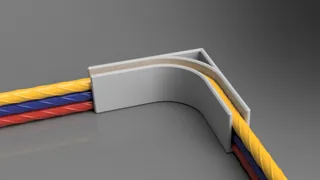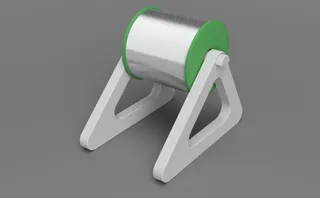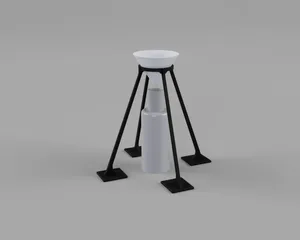3D Printed Circuit Splitter and Flow Restriction Devices for Multiple Patient Lung Ventilation
Description
PDFTHIS HAS NOT BEEN TESTED ON A HUMAN
Let's be clear: if you print this and use this on a patient, that is your responsibility. I make no representations as to the safety of this device. It's an experimental model designed to stimulate conversation. The world is running out of equipment, we need to think about alternatives.
This post accompanies a submission (18 March 2020) to the journal Anaesthesia entitled "3D Printed Circuit Splitter and Flow Restriction Devices for Multiple Patient Lung Ventilation Using One Anaesthesia Workstation or Ventilator" (https://doi.org/10.1111/anae.15063).
The COVID-19 condition/SARS-CoV-2 virus has resulted in widespread ventilator shortages.
This device enables multiple patients to be ventilated with the one anaesthesia machine or intensive care ventilator, similar to that described in Dr Charlene Irwin Babcock's recent video: https://www.youtube.com/watch?v=uClq978oohY
For a more thorough explanation of the issues, see this excellent article from a group in Belgium: https://medium.com/@pinsonhannah/a-better-way-of-connecting-multiple-patients-to-a-single-ventilator-fa9cf42679c6 or my group's article in Anaesthesia (https://doi.org/10.1111/anae.15078)
This device takes that concept one step further by enabling the selective application of flow resistance to one of the patient's inspiratory limbs, thus enabling the ventilation of two or more patients with differing inspiratory pressures. Formal laboratory testing is pending. It is designed to be compatible with the international standards for 22mm breathing circuits.
Please see the additional photos and diagrams for the suggested connection layout.
The attached 3MF file contains all the correct settings for Prusa Slicer. The G code is for an Original Prusa i3 MK3S MMU2S single filament configuration.
Printing 2x splitters and 1x flow restrictor should take 6 hours.
The 4 way splitter has not been tested, but is published by popular demand.
The author (Alexander Linden Clarke) makes no representations as to the suitability of this device for clinical practice and takes no responsibility for the misuse of this device. This device has not been tested or approved by any governmental organisations.
Technical drawings are on my website: https://alexanderclarke.id.au/
Twitter: @fifteenforty
Resources for those interested:
Design of anaesthesia breathing circuit connectors: https://www.ncbi.nlm.nih.gov/pubmed/6640402
FAQ
- Why is it so big? Why didn't you use a smaller design?
- To make this reliably printable on a wide variety of FDM machines, it was important to ensure that the contact area on the print bed was large, there are minimal overhangs and that it does not require high resolution (< 200micron layer height). This also increases the part strength.
- The part is designed to print with the female adapters on the print bed, above a raft. In my testing, this results in the most reliable fit. Printing the male adapter on the print bed means that any "elephant's foot" tends to make fitting the parts together difficult. The female connector is chamfered to prevent this issue.
- More flex is required in the male connectors
The design looks more complex and bigger than it should be, but this is deliberate.
Print instructions
Suggested settings for a Prusa i3 MK3S:
- 200micron QUALITY preset
- Brim
- Raft
To prevent air leak:
- 100% infill
- 25 perimeters (which actually means that there is no infill!)
- PLA seems to work better than PETG
Tags
Model origin
The author hasn't provided the model origin yet.




